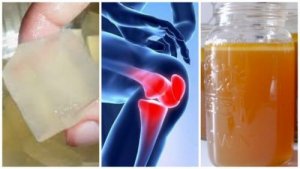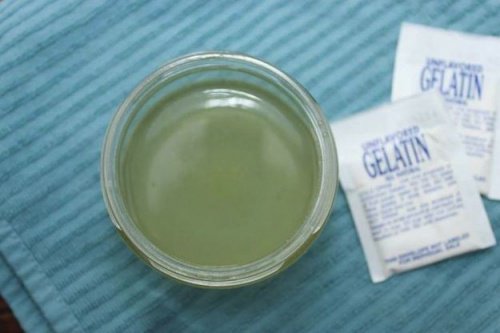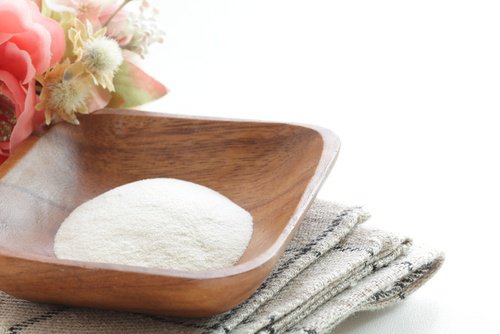Discover 3 Gelatin Remedies to Alleviate Joint Pain


Reviewed and approved by the pedagogue in physical education and nutritionist Elisa Morales Lupayante
Joint pain can occur as a result of trauma, strain, or the development of certain chronic conditions.
The symptoms can affect your quality of life by limiting your movements and leading to disabilities.
The elderly are the group most affected by joint pain. With this, you suffer from the consequences of the breakdown of cartilage, tendons, and ligaments.
It’s also common among people who suffer from rheumatoid arthritis, osteoarthritis, and other inflammatory conditions that affect the joints and skeletal system.
Treatment to control joint pain typically includes a variety of painkillers and physical therapy.
There are natural supplements, however, whose properties help reduce inflammation and soothe the symptoms. Natural gelatin remedies are one of these products, known for their high nutritional value.
Today we want to share with you the main benefits of gelatin for joint pain and three gelatin remedies you can try for yourself at home.
What are the benefits of natural gelatin remedies for joint pain?

Because it is derived from animal collagen, it has a very high protein content (about 90%).
Gelatin also contains water, minerals, vitamins, and other important nutrients that promote healthy bones, joints, hair, and nails.
While you get most of these benefits from the consumption of gelatin, there are some topical solutions that will bring you relief.
Please read: Find a Fantastic Gelatin Facial Mask
Gelatin remedies
1. Compresses

Gelatin compresses are a useful way to reduce inflammation and control pain that affects the joints.
They have a relaxing effect that reduces feelings of fatigue after excessive physical activity or also doing something that strains your body.
Ingredients
- 1 tablespoon of unflavored gelatin (10 g)
- 1 liter of water
- A wide bandage
- 1 sheet of plastic wrap
What should you do?
- Firstly, soak the bandage in hot water and fold it over several times.
- Then, add the unflavored gelatin to the bandage and apply it to any painful areas.
- Next, cover with plastic wrap and leave the compress on for an hour.
- Finally, repeat this every day until your pain subsides.
2. Gelatin with cold water
This remedy will provide your body with a lot of proline and hydroxyproline, two essential amino acids that repair connective damage and soothe joint, muscle, and bone pain.
Ingredients
- 5 g of unflavored gelatin (1/2 tablespoon)
- 100 ml of ice water (1/2 a cup)
- 100 ml of warm water (1/2 cup)
What should you do?
- First of all, add the gelatin to the ice water and let it sit overnight.
- In the morning, pour in the warm water and heat with a double boiler.
- When you see that the gelatin is ready, remove it from heat and wait a few minutes before consuming it.
- Most importantly, eat it on an empty stomach at least half an hour before your regular breakfast.
- Lastly, if you want to give it a more pleasant flavor, you can mix in a little orange juice or other fruit juice.
Want to know more? See: Joint Pain Relief with Lemon Peel and Olive Oil
3. Natural gelatin milk

Gelatin milk is a great option for breakfast because it helps “recharge” your body’s energy stores.
The 18 essential amino acids and high level of collagen help strengthen joints and bones.
Ingredients
- 2 tablespoons of unflavored gelatin (20 g)
- 3/4 cup of cold milk (150 ml)
What should you do?
- Add the gelatin to the cold milk and let it stand for at least an hour.
- Heat the mixture in a double boiler and remove from heat just before it begins to boil.
- You can add a little honey to sweeten it if you like.
- Consume the gelatin milk after letting it cool for 10 to 15 minutes.
- Above all, for joint pain, it’s a good idea to take this remedy three weeks in a row.
In conclusion, all of the gelatin remedies here are just to help reduce pain associated with joint problems. If your pain persists or increases after two weeks of treatment, see your doctor to get a proper diagnosis.
Although gelatin is safe and rarely causes side effects, experts recommend avoiding it if you suffer from liver problems or have chronic digestive difficulties.
All cited sources were thoroughly reviewed by our team to ensure their quality, reliability, currency, and validity. The bibliography of this article was considered reliable and of academic or scientific accuracy.
- Gomez-Guillen, M. C., Gimenez, B., Lopez-Caballero, M. E., & Montero, M. P. (2011). Functional and bioactive properties of collagen and gelatin from alternative sources: A review. Food Hydrocolloids. https://doi.org/10.1016/j.foodhyd.2011.02.007
- Volk, S. W., Kapatkin, A. S., Haskins, M. E., Walton, R. M., & D’Angelo, M. (2003). Gelatinase activity in synovial fluid and synovium obtained from healthy and osteoarthritic joints of dogs. American Journal of Veterinary Research. https://doi.org/10.2460/ajvr.2003.64.1225
- Karim, A. A., & Bhat, R. (2009). Fish gelatin: properties, challenges, and prospects as an alternative to mammalian gelatins. Food Hydrocolloids. https://doi.org/10.1016/j.foodhyd.2008.07.002
This text is provided for informational purposes only and does not replace consultation with a professional. If in doubt, consult your specialist.








